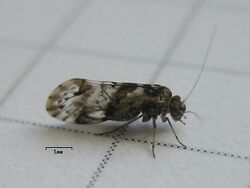Biology:Trichadenotecnum
| Trichadenotecnum | |
|---|---|

| |
| Trichadenotecnum sexpunctatum | |
| Scientific classification | |
| Domain: | Eukaryota |
| Kingdom: | Animalia |
| Phylum: | Arthropoda |
| Class: | Insecta |
| Order: | Psocodea |
| Family: | Psocidae |
| Subfamily: | Psocinae |
| Tribe: | Ptyctini |
| Genus: | Trichadenotecnum Enderlein, 1909 |
| Diversity | |
| at least 210 species | |
Trichadenotecnum is a genus of insects in the order Psocoptera, the booklice, barklice, and bookflies. It is one of the largest genera, including over 200 described species.[1]
The biology of the genus is similar to that of many other booklice. T. alexanderae, for example, feeds on pleurococcine algae and the female reproduces by mating with a male.[2] In some closely related species, the females instead undergo thelytoky, producing eggs without fertilization.[3]
Trichadenotecnum is well separated from related genera,[4] forming a monophyletic group.[1] The large genus is divided into several clades, some of which are further divided into subclades. These groups are mainly separated on the basis of the morphology of the genitalia, which is quite variable in this genus. The male genitalia are the most important structures used to distinguish species. Some males have distinctly asymmetrical genitalia.[5]
In general, these insects have forewings that are about 2 or 3 millimeters long and have variable spotted patterns.[5]
Trichadenotecnum occur throughout most of the world, except for Australia and New Zealand, which have no native species.[5][6]
See also
References
- ↑ 1.0 1.1 Yoshizawa, K., et al. (2010). Description of a new species of the Trichadenotecnum roesleri species group from Brazil (Insecta: Psocodea:“Psocoptera”: Psocidae) and its phylogenetic implications. Studies on Neotropical Fauna and Environment 45(1) 61-66.
- ↑ Betz, B. W. (1983). The biology of Trichadenotecnum alexanderae Sommerman (Psocoptera: Psocidae). II. Duration of biparental and parthenogenetic reproductive abilities. Journal of the Kansas Entomological Society 56(3) 420-26.
- ↑ Betz, B. W. (1983). Systematics of the Trichadenotecnum alexanderae species complex (Psocoptera: Psocidae) based on an investigation of modes of reproduction and morphology. The Canadian Entomologist 115(10) 1329-54.
- ↑ Yoshizawa, K. and K. P. Johnson. (2008). Molecular systematics of the barklouse family Psocidae (Insecta: Psocodea:‘Psocoptera’) and implications for morphological and behavioral evolution. Molecular Phylogenetics and Evolution 46(2) 547-59.
- ↑ 5.0 5.1 5.2 Yoshizawa, K., et al. (2008). Systematics and biogeography of the New World species of Trichadenotecnum Enderlein (Insecta: Psocodea:"Psocoptera": Psocidae). Zoological Journal of the Linnean Society 153(4) 651-723.
- ↑ Kentjonowati, E. S. and T. R. New. (2005). The genus Trichadenotecnum (Insecta: Psocoptera: Psocidae) in Sumatra, Indonesia, with description of thirteen new species. Records of the Australian Museum 57(1) 15-38.
Further reading
- Mockford, E. L. (1974). Trichadenotecnum circularoides (Psocoptera: Psocidae) in southeastern United States, with notes on its reproduction and immature stages. Florida Entomologist 57(4) 369-70.
- Yoshizawa, K. (2001). A systematic revision of Japanese Trichadenotecnum Enderlein (Psocodea:'Psocoptera': Psocidae: Ptyctini), with redefinition and subdivision of the genus. Invertebrate Systematics 15(2) 159-204.
- Yoshizawa, K. (2003). Two new species that are likely to represent the most basal clade of the genus Trichadenotecnum (Psocoptera: Psocidae). Entomological Science 6(4) 301-08.
- Yoshizawa, K. (2004). Molecular phylogeny of major lineages of Trichadenotecnum and a review of diagnostic morphological characters (Psocoptera: Psocidae). Systematic Entomology 29(3) 383-94.
- Yoshizawa, K., (2007). Systematic study of the genus Trichadenotecnum in Nepal (Psocodea:'Psocoptera': Psocidae). Insecta Matsumurana. New Series 63, 1-33.
Wikidata ☰ Q4051740 entry
 |

